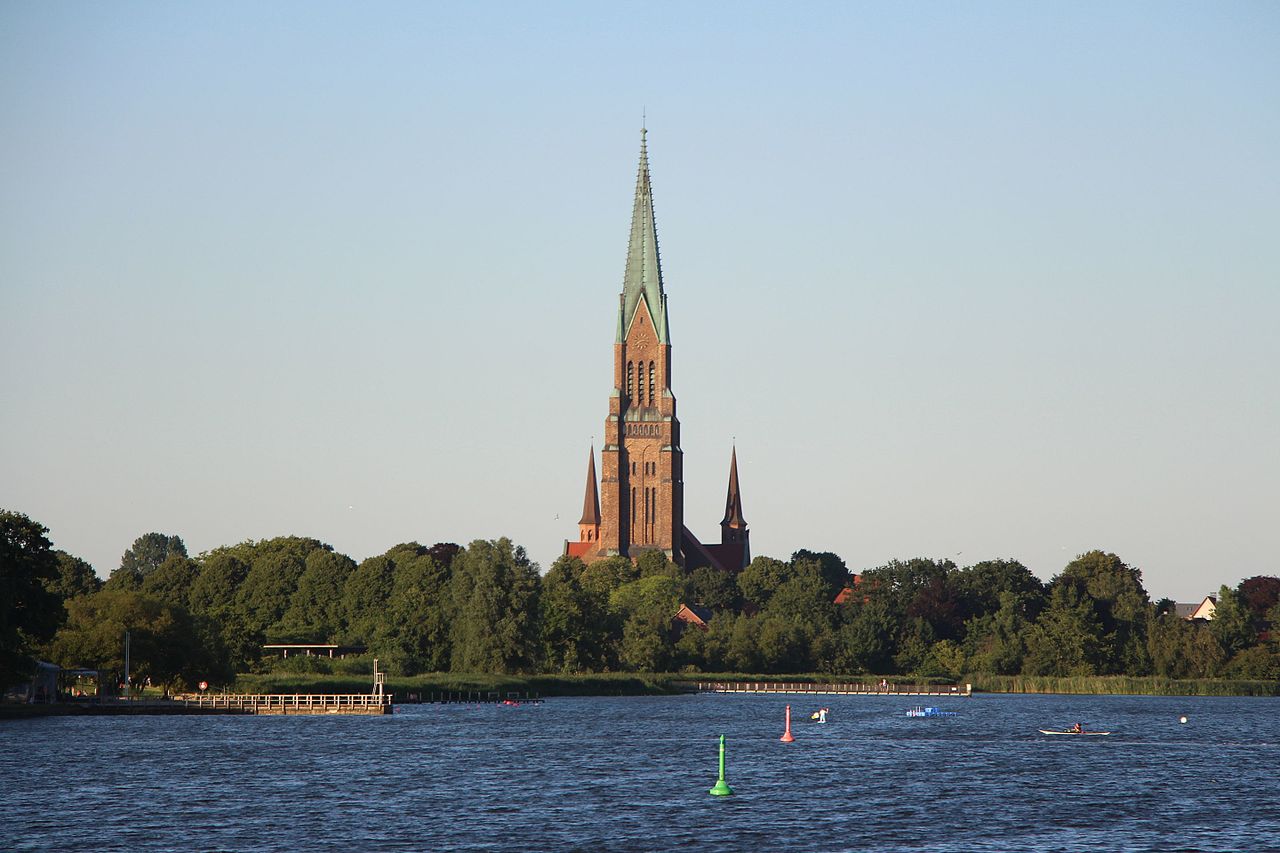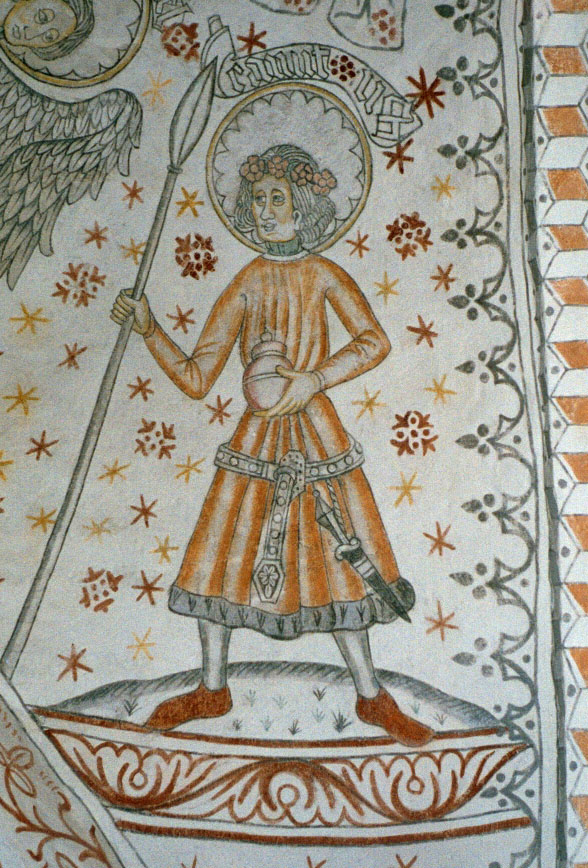by Susan Flantzer
© Unofficial Royalty 2025

St. Peter’s Cathedral; Credit – By Ziko – Own work, CC BY-SA 4.0, https://commons.wikimedia.org/w/index.php?curid=50332912
Saint Peter’s Cathedral in Schleswig, Germany, named for Saint Peter the Apostle, is also called Schleswig Cathedral. The first cathedral in Schleswig was built after the Roman Catholic Diocese of Schleswig was founded in 947. However, neither the size nor the exact location of this cathedral is known. Before the Protestant Reformation, the cathedral was a Roman Catholic church. Now Saint Peter’s Cathedral is the seat of the Bishop of the Schleswig and Holstein Diocese of the Evangelical Lutheran Church in Northern Germany. Rulers of the Duchy of Schleswig, the Duchy of Holstein-Gottorp, and the Duchy of Schleswig-Holstein-Sonderburg-Glücksburg and their families are buried at Saint Peter’s Cathedral.

Cnut Lavard, son of King Eric I of Denmark, the first Duke of Schleswig; Credit – Wikipedia
The cathedral has connections to Denmark, and some Danish royals are buried in the cathedral. In 1115, King Niels of Denmark created his nephew Cnut Lavard, son of his predecessor King Eric I of Denmark, Earl of Schleswig. Cnut Lavard used the title Earl of Schleswig for only a short time before he began to style himself Duke of Schleswig. In 1544, Adolf of Denmark, his brother Johann of Denmark, and their half-brother King Christian III of Denmark, all sons of King Frederik I of Denmark, divided and then ruled the duchies of Schleswig and Holstein. Parts of the duchies of Schleswig and Holstein, also known as Ducal Holstein, were ruled for two hundred years by various Dukes of Schleswig and Dukes of Schleswig-Holstein-Gottorp, a branch of the elder Danish line of the German House of Oldenburg. Other parts of the duchies were ruled by the Kings of Denmark. In 1721, the Dukes of Schleswig-Holstein-Gottorp lost their power when their land holdings became part of Denmark. After the 1864 Second Schleswig War, Schleswig and Holstein were annexed by the Kingdom of Prussia.
*********************
The Construction of Saint Peter’s Cathedral

Interior of St. Peter’s Cathedral; Credit – By Frank Vincentz – Own work, CC BY-SA 3.0, https://commons.wikimedia.org/w/index.php?curid=30812608
Around 1030, the construction of a new Romanesque cathedral began and would continue over several hundred years. During the reign of Cnut Lavard, the first Duke of Schleswig (reigned 1115 – 1134), the semicircular apse was built and the transept was built 1180 – 1200. During renovations between 1200 and 1500, the Romanesque nave cathedral became a Gothic three-nave hall cathedral. The vaulted cathedral chapter house in the northern aisle was added around 1220 – 1230 and the nave vault around 1230 – 1270. Originally, the cathedral had two towers, but they collapsed in 1275 and were not rebuilt.
The cathedral did not have a tower until German architect and archaeologist Friedrich Adler constructed a 112-meter/368-foot Neo-Gothic tower between 1888 and 1894 at the request of Wilhelm II, German Emperor and King of Prussia.
*********************
Saint Peter’s Portal

Saint Peter’s Portal; Credit – Wikipedia
The cathedral’s main entrance is the 1180 St. Peter’s Portal. It was constructed using granite, red sandstone from Scania, limestone from Gotland, and tuff (a light, porous volcanic rock) from the Rhineland. The tympanum (the semi-circular or triangular decorative wall surface over an entrance, door, or window) depicts Jesus Christ between the evangelists and saints.
*********************
The Sacristy
The sacristy, where the priest and attendants put on their vestments and prepare for services, was built around 1480. It served as the meeting place for the cathedral chapter (the group of clerics formed to advise a bishop) and after 1567, as a lecture hall for the cathedral school. After the Protestant Reformation, it was converted into a burial crypt for the Dukes of Holstein-Gottorp.
*********************
The Choir
The choir is the part of a cathedral between the altar and the nave, the central aisle. The choir of Saint Peter’s Cathedral was expanded and painted at the end of the 13th century. The frescoes depict the Annunciation, the Coronation of Mary, Saint Catherine, Saint Philip, Saint Peter, the Deesis (Christ enthroned holding a book with the Virgin Mary and St. John the Baptist at his sides), and angels. The choir stalls were built at the beginning of the 16th century by an unknown artist using the pseudonym Magister Rusticus.
*********************
The Schwahl

The Schwahl; Credit – By Kirchenfloh – Own work, CC BY-SA 4.0, https://commons.wikimedia.org/w/index.php?curid=116866810
In Danish-Low German, Schwahl means “half-open corridor outside a building.” The Schwahl is located on the north side of the nave and was built from brick 1310 – 1320. It is a corridor leading to the cloisters and a processional corridor leading out of the cathedral and back into the cathedral. Restored frescoes on the wall panels depicting the life of Jesus are from the time of construction. Mythical creatures are depicted on the vaults, the arched ceiling. The Schwahl is not regularly open to the public to protect the frescoes from dirt and condensation.
*********************
The Brüggemann Altar

The Brüggemann Altar; Credit – By W. Bulach – Own work, CC BY-SA 4.0, https://commons.wikimedia.org/w/index.php?curid=75089166
The impressive Brüggemann Altar was made of oak by Hans Brüggemann, a German sculptor and woodcarver, between 1514 and 1521. The huge altar – 12.60 meters/42 feet high – depicts sixteen scenes from Christ’s Passion with a total of more than 400 finely carved unpainted figures. The altar was originally made for Bordesholm Abbey, then in the Duchy of Holstein. After the abbey’s dissolution due to the Protestant Reformation, Christian Albrecht, Duke of Holstein-Gottorp, who is buried in St. Peter’s Cathedral, arranged for the altar’s transfer to St. Peter’s Cathedral in 1666.

Detail from the Brüggemann Altar – Jesus carrying the cross; Credit – By Uli Poppe Own work, CC BY-SA 3.0, https://commons.wikimedia.org/w/index.php?curid=7616563
*********************
Cenotaph of Frederik I, King of Denmark and Norway and Duke of Schleswig and Holstein

Cenotaph of Frederik I, King of Denmark and Norway, Duke of Schleswig and Holstein; Credit – Wikipedia by Von Arnoldius
In the north choir nave, there is a cenotaph, an empty tomb, created by Flemish sculptor Cornelis Floris de Vriendt for Frederik I, King of Denmark and Norway and Duke of Schleswig and Holstein, and erected in the cathedral in 1552. Frederik I, who died in 1533, was the last Roman Catholic monarch of Denmark. He is buried in St. Peter’s Cathedral but the location of his burial is unknown.
*********************
Burials at St. Peter’s Cathedral
Sarcophagi at St. Peter’s Cathedral; Credit – By Västgöten – Own work, CC BY-SA 3.0, https://commons.wikimedia.org/w/index.php?curid=8972859
Burials at St. Peter’s Cathedral include:
- Eric I Abelson, Duke of Schleswig (1241 – 1272)
- Valdemar III Abelson, Duke of Schleswig (1238 – 1271)
- Valdemar IV, Duke of Schleswig (circa 1262 – 1312)
- Eric II, Duke of Schleswig (circa 1290 – 1325)
- Frederik I, King of Denmark and Norway, Duke of Schleswig and Holstein (1471 – 1533), the last Catholic monarch of Denmark and Norway
- Gustav Trolle, Archbishop of Uppsala, Primate of Sweden (1488 – 1535)
- Frederik of Denmark, Prince-Bishop of Hildesheim and Bishop of Schleswig (1532 – 1556), son of King Frederik I of Denmark and Norway
- Sophie of Pomerania, Queen of Denmark and Norway (1498 – 1568), second wife of King Frederik I of Denmark and Norway
- Christian of Schleswig-Holstein-Gottorp (1576 – 1577), infant son of Adolf of Denmark, Duke of Holstein-Gottorp
- Johann II, Duke of Schleswig-Holstein-Haderslev (1521 – 1580), son of King Frederik I of Denmark and Norway
- Adolf of Denmark, Duke of Holstein-Gottorp (1526 – 1586), son of Frederik I, King of Denmark and Norway
- Frederik II, Duke of Holstein-Gottorp (1568 – 1587), son of Adolf of Denmark, Duke of Holstein-Gottorp
- Philipp, Duke of Holstein-Gottorp (1570 – 1590), son of Adolf of Denmark, Duke of Holstein-Gottorp
- Christine of Hesse, Duchess of Holstein-Gottorp (1543 – 1604) wife of Adolf of Denmark, Duke of Holstein-Gottorp
- Christian of Holstein-Gottorp (1609 – 1610), infant son of Johann Adolf, Duke of Holstein-Gottorp
- Johann Adolf, Duke of Holstein-Gottorp (1575 – 1616), son of Adolf of Denmark, Duke of Holstein-Gottorp
- Anna of Holstein-Gottorp (1604 – 1623), daughter of Johann Adolf, Duke of Holstein-Gottorp
- Adolf of Holstein-Gottorp (1600 – 1631), son of Johann Adolf, Duke of Holstein-Gottorp
- Adolf August of Holstein-Gottorp (born and died 1637), infant son of Friedrich III, Duke of Holstein-Gottorp
- Augusta of Denmark, Duchess of Holstein-Gottorp (1580 – 1639), daughter of Frederik II, King of Denmark and wife of Johann Adolf, Duke of Holstein-Gottorp
- Johann Adolf of Schleswig-Holstein-Gottorp (1632 – 1633), infant son of Friedrich III, Duke of Holstein-Gottorp
- Johann Friedrich of Holstein-Gottorp, Prince-Archbishopric of Bremen, Prince-Bishopric of Lübeck, and the Prince-Bishopric of Verden (1579 – 1634), son of Adolf of Denmark, Duke of Holstein-Gottorp
- Gustav Ulrich of Holstein-Gottorp (born and died 1642), infant son of Friedrich III, Duke of Holstein-Gottorp
- Adolf of Holstein-Gottorp (1647 – 1648), infant son of Friedrich III, Duke of Holstein-Gottorp
- Johann of Holstein-Gottorp (1606 – 1655), son of Johann Adolf, Duke of Holstein-Gottorp
- Johann Georg of Holstein-Gottorf (1638 – 1655), son of Friedrich III, Duke of Holstein-Gottorp
- Friedrich III, Duke of Holstein-Gottorp (1597 – 1659), son of Johann Adolf, Duke of Holstein-Gottorp
- Marie Elisabeth of Saxony, Duchess of Holstein-Gottorp (1610 – 1684), wife of Friedrich III, Duke of Holstein-Gottorp
- Christine Sabine of Holstein-Gottorp (1643 – 1644), infant daughter of Friedrich III, Duke of Holstein-Gottorp
- Elisabeth Sophie of Holstein-Gottorp (born and died 1647), infant daughter of Friedrich III, Duke of Holstein-Gottorp
- Christian Albrecht, Duke of Holstein-Gottorp, Bishop of Lübeck (1641 – 1694), son of Friedrich III, Duke of Holstein-Gottorp
- Friedrich IV, Duke of Holstein-Gottorp (1671 – 1702)
- Frederika Amalia of Denmark and Norway, Duchess of Holstein-Gottorp (1649 – 1704), wife of Christian Albert, Duke of Holstein-Gottorp, daughter of Frederik III of Denmark and Norway
- Conrad, Count von Reventlow, Grand Chancellor of Denmark (1644 – 1708)
- Anna Dorothea von Schleswig-Holstein-Gottorp (1640 – 1713), daughter of Friedrich III, Duke of Holstein-Gottorp
- Prince Christian of Hesse (1776 – 1814), son of Prince Karl of Hesse-Kassel and Princess Louise of Denmark and Norway
- Princess Louise of Denmark and Norway (1750 – 1831), wife of Prince Karl of Hesse-Kassel, daughter of Frederik V, King of Denmark and Norway and Princess Louise of Great Britain
- Friedrich Wilhelm, Duke of Schleswig-Holstein-Sonderburg-Glücksburg (1785 – 1831)
- Prince Karl of Hesse-Kassel, Governor of Schleswig-Holstein (1744 – 1836), son of Friedrich II, Landgrave of Hesse-Kassel and his first wife Princess Mary of Great Britain
- Louise Caroline of Hesse-Kassel, Duchess of Schleswig-Holstein-Sonderburg-Glücksburg (1789 – 1867), wife of Friedrich Wilhelm, Duke of Schleswig-Holstein-Sonderburg-Glücksburg
- Friedrich, Duke of Schleswig-Holstein-Sonderburg-Glücksburg (1814 – 1885), son of Friedrich Wilhelm, Duke of Schleswig-Holstein-Sonderburg-Glücksburg
- Princess Adelheid of Schaumburg-Lippe, Duchess of Schleswig-Holstein-Sonderburg-Glücksburg (1821 – 1899), wife of Friedrich, Duke of Schleswig-Holstein-Sonderburg-Glücksburg
This article is the intellectual property of Unofficial Royalty and is NOT TO BE COPIED, EDITED, OR POSTED IN ANY FORM ON ANOTHER WEBSITE under any circumstances. It is permissible to use a link that directs to Unofficial Royalty.
Works Cited
- Autoren der Wikimedia-Projekte. (2004). Kirchengebäude in Schleswig. Wikipedia.org; Wikimedia Foundation, Inc. https://de.wikipedia.org/wiki/Schleswiger_Dom
- Autoren der Wikimedia-Projekte. (2007). Wikimedia-Liste. Wikipedia.org; Wikimedia Foundation, Inc. https://de.wikipedia.org/wiki/Liste_von_Grabst%C3%A4tten_europ%C3%A4ischer_Monarchen
- Bidragsydere til Wikimedia-projekter. (2003). Domkirke i Sydslesvig. Wikipedia.org; Wikimedia Foundation, Inc. https://da.wikipedia.org/wiki/Slesvig_Domkirke
- Der St. Petri-Dom zu Schleswig. (2025). Mein-Schleswiger-Dom.de. https://www.mein-schleswiger-dom.de/
- Saint Petri Dom in Schleswig, Schleswig-Holstein – Find a Grave Cemetery. (2025). Findagrave.com. https://www.findagrave.com/cemetery/2161243/saint-petri-dom
- Wikipedia Contributors. (2025). Schleswig Cathedral. Wikipedia; Wikimedia Foundation.
